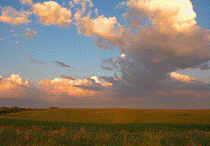North American Prairie Conference
Date of this Version
1989
Document Type
Article
Abstract
Two cultivars each of four warm-season grass species under three N fertilizer treatments and three harvesting regimes were studied to determine the effect of nitrogen fertilizer and harvest date on forage yield. Research was conducted in eastern Nebraska on an alluvial soil. The eight grasses studied were 'Blaze' and 'PM-K-129' little bluestem [Schizachyrium scoparium (Michx.) Nash], 'Cave-in-Rock' and 'Pathfinder' switchgrass (Panicum virgatum L.), 'Holt' and 'Oto' indiangrass [Sorghastrum nutans (L.) Nash], and 'Kaw' and 'Pawnee' big bluestem (Andropogon gerardii var. gerardii Vitman). Dates of harvest were mid-July, mid-August, and early October. Regrowth from plots harvested in mid-July and mid-August was harvested in early October. Yields, analyzed by orthogonal comparisons, tested quadratic and linear effects of harvest date and N treatments. Total yields of all cultivars, except 'Cave-in-Rock', showed quadratic effects. Mid-August yields were greater than the averaged yields of mid-July and early October harvests. Yields of 'Blaze', 'Pathfinder', and 'Holt' exhibited no significant differences between mid-July and early October harvests. Nitrogen was applied at the rates of 0, 100, and 200 kg/ ha. These high rates of nitrogen were applied to determine yield potential of the grasses. A large increase in dry matter production occurred following the addition of 100 kg/ha of N fertilizer. For most cultivars, a slight yield increase occurred as N was increased from 100 to 200 kg/ha, Yields obtained in this research indicate a high yield potential for these warm season grasses.



Comments
Published in Prairie Pioneers: Ecology, History and Culture: Proceedings of the Eleventh North American Prairie Conference, August 7-11, 1988, Lincoln, Nebraska (Lincoln, NE 1989).